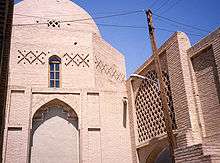Khorasani style
For the Persian poetic style, see Khorasani style (poetry).
The "Khorasani style" (Persian: شیوه معماری خراسانی) is a style (sabk) of architecture when categorizing Iranian architecture development in history. It is the first style of architecture appearing after the Conquest of Persia, but is highly influenced by pre-Islamic designs.[1] Landmarks of this style appear in the late 7th century, and span through the end of the 10th century CE.[2]
Examples of this style are Mosque of Nain, Tarikhaneh-i Damghan, and Jame mosque of Isfahan
Gallery
-

Mosque of Nain: Na'in has one of Iran's oldest mosques still standing.
-
Ardestan Congregation Mosque
References
- ↑ Fallāḥʹfar, Saʻīd (Persian: سعید فلاحفر). The Dictionary of Iranian Traditional Architectural Terms (Farhang-i vāzhahʹhā-yi miʻmārī-i sunnatī-i Īrān فرهنگ واژههای معماری سنتی ایران). Kamyab Publications (Persian: انتشارات کامیاب). Kāvushʹpardāz. 2000, 2010. Tehran. ISBN 978-964-2665-60-0 US Library of Congress LCCN Permalink: http://lccn.loc.gov/2010342544 pp.44
- ↑ Sabk Shenasi Mi'mari Irani (Study of styles in Iranian architecture), M. Karim Pirnia. 2005. ISBN 964-96113-2-0 pp.134-135
See also
External links
This article is issued from Wikipedia - version of the 11/5/2016. The text is available under the Creative Commons Attribution/Share Alike but additional terms may apply for the media files.
